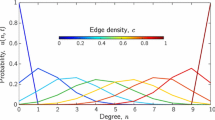Abstract
We study a family of equivalent continuum models in one dimension. All these models map onto a single equation and include simple chemical reactions, diffusion in presence of a trap or a source and an ideal polymer chain near an attractive or repulsive site. We have obtained analytical results for the survival probability, total growth rate, statistical properties of nearest-neighbour distribution between a trap and unreacted particle and mean-squared displacement of the polymer chain. Our results are compared with the known asymptotic results in the theory of discrete random walks on a lattice in presence of a defect.
Similar content being viewed by others
References
Balagurov B Ya and Vaks V G 1973Zh. Eksp. Theor. Fiz. 65 1939 (1974Sov. Phys. — JETP 38 968)
ben-Avraham D, Redner S and Cheng Z 1989J. Stat. Phys. 56 437
ben-Avraham D and Weiss G H 1989Phys. Rev. A39 6436
Bilek O and Skála L 1986Phys. Lett. A119 300
Blinder S M 1988Phys. Rev. A37 973
Bunde A, Havlin S, Nossal R and Stanley H E 1985Phys. Rev. B32 3367
Bunde A, Moseley L L, Stanley H E, ben-Avraham D and Havlin S 1986Phys. Rev. A34 2575
Donsker M D and Varadhan S R S 1979Commun. Pure Appl. Math. 32 721
Ebeling W, Engel A, Esser B and Feistel R 1984J. Stat. Phys. 37 369
Edwards S F and Muthukumar M 1988J. Chem. Phys. 89 2435
Grassberger P and Procaccia I 1982J. Chem. Phys. 77 12
Haus J W and Kehr K W 1987Phys. Rep. 150 263
Havlin S and ben-Avraham D 1987Adv. Phys. 36 695
Havlin S, Larralde H, Kopelman R and Weiss G H 1990Physica A169 337
Jayannavar A M and Köhler J 1990Phys. Rev. A41 3391, and references therein
Jayannavar A M 1991aSolid State Commun. 77 457
Jayannavar A M 1991bPhysica A179 243
Kardar K, Parisi G and Zhang Y C 1986Phys. Rev. Lett. 56 889
Majumdar S N 1990Physica A169 207
Medina E, Hwa T, Kardar M and Zhang Y C 1989Phys. Rev. A39 3053
Nattermann T and Renz W 1989Phys. Rev. A40 4675
Parris P E 1989Phys. Rev. B40 4928
Postma B J 1984Am. J. Phys. 52 725
Redner S and Kang K 1984Phys. Rev. A30 3362
Smoluchowski M V 1917Z. Phys. Chem. 92 129
Szabo A, Zwanzig R and Agmon N 1988Phys. Rev. Lett. 61 2496
Taitelbaum H, Kopelman R, Weiss G H and Havlin S 1990Phys. Rev. A41 3116
Taitelbaum H 1991Phys. Rev. A43 6592
Valsakumar M C and Murthy K P N 1990Pramana — J. Phys. 35 461
Webman I 1984Phys. Rev. Lett. 62 357
Weiss G H 1981J. Math. Phys. 22 562
Weiss G H and Rubin R J 1983Adv. Chem. Phys. 52 363
Weiss G H, Kopelman R and Havlin S 1989Phys. Rev. A39 466, and references therein
Author information
Authors and Affiliations
Rights and permissions
About this article
Cite this article
Datta, P.K., Jayannavar, A.M. Self-segregation in chemical reactions, diffusion in a catalytic environment and an ideal polymer near a defect. Pramana - J Phys 38, 257–269 (1992). https://doi.org/10.1007/BF02875372
Received:
Revised:
Issue Date:
DOI: https://doi.org/10.1007/BF02875372



